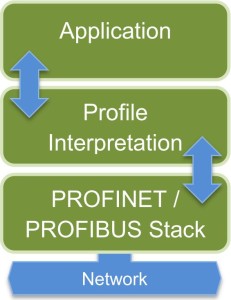PROFIsafe, PROFIdrive, PROFIenergy… these terms are pretty common in the PI world. How are they used in the real world? And how do they actually work?
PROFINET and PROFIBUS are both great protocols that can be used to send data across a network. But that’s where their responsibilities end: they don’t assign any specific meaning to the data that they carry. This means that each manufacturer that uses a PROFI protocol has to develop their own API to allow a controller or master to work with their application specific code that runs on top of the networking stack.
Profiles address this gap of both PROFIBUS and PROFINET: while these protocols provide a way to move data across a network, they don’t give the data any structure or  meaning. Profiles are implemented as an additional layer that sits between the device application and the PROFINET/PROFIBUS networking stack, providing a standard framework for the device application to talk to the controller application.
meaning. Profiles are implemented as an additional layer that sits between the device application and the PROFINET/PROFIBUS networking stack, providing a standard framework for the device application to talk to the controller application.
But why add this extra layer of complexity? It’s to streamline engineering and maintenance. By putting just a little abstraction between the device application code and the network, Controllers or Masters can access the profile with a generic driver for any Device or Slave.
For instance, an application engineer that has drives from different manufacturers that all implement PROFIdrive can use the same chunk of application code to access all the drives. This saves not only time and money, but also the frustration and headaches that comes from learning, implementing and debugging those three manufacturer’s APIs.
It’s the same with PROFIsafe. The profile is implemented in devices independently of the device’s application code. A PROFIsafe controller or master that connects to the PROFIsafe device can set up a SIL 3 connection without much more legwork on the part of the application engineer than it takes to establish a regular PROFINET / PROFIBUS connection.
There are more profiles than PROFIdrive or PROFIsafe. There are profiles defined for everything from trains (yes, trains) to HART, from IO-Link to PROFIenergy. There’s a complete list, along with the profile publications, on the PI website. But raw specification documents can make for pretty dry reading, so if you have questions about using or implementing a profile feel free to drop us a line here at the PROFI Interface Center or a global PI Competence Center. We’re always happy to help.
— Kyle McMillan, PROFI Interface Center
For more details, download the System Description: PROFILE Technology and Application.
For a quick overview, watch MinutePROFINET: PROFINET Application Profiles.
